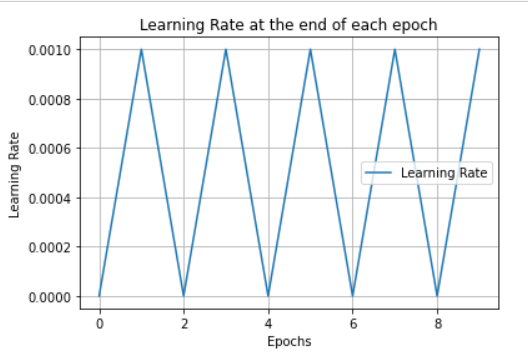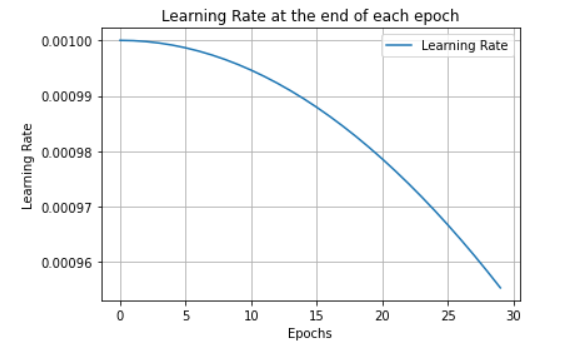Here is my code. I tried your method and got the error: ‘CosineAnnealingLR’ object has no attribute 'get_last_lr
# Run the training batches
def train(train_loader, model, criterion, optimizer, i,trn_corr):
# switch to train mode
MobileNet.train()
epoch = i
#lrs.step()
for b, (images, labels) in enumerate(train_loader):
if torch.cuda.is_available():
images = images.cuda()
labels = labels.cuda()
b+=1
# Apply the model
y_pred = MobileNet(images)
loss = criterion(y_pred, labels)
# Tally the number of correct predictions
train_predicted = torch.max(y_pred.data, 1)[1]
batch_corr = (train_predicted == labels).sum()
trn_corr += batch_corr
accuracy = trn_corr.item()*100/(b*batch)
# Update parameters
optimizer.zero_grad()
loss.backward()
optimizer.step()
lrs.step()
lrs_track.append(lrs.get_last_lr())
# Print interim results
if b%2 == 0:
print(f'epoch: {epoch:2} batch: {b:4} loss: {loss.item():10.8f} \accuracy: {accuracy:3.3f}%')
if b%14 == 0:
train_acc.append(accuracy)
train_losses.append(loss)
train_correct.append(trn_corr)
mean_loss = sum(train_losses)/len(train_losses)
labels = labels.cpu()
train_predicted = train_predicted.cpu()
print(classification_report(labels.view(-1), train_predicted.view(-1), target_names=class_names))
print("\n")
for param_group in optimizer.param_groups:
lr_track.append(param_group['lr'])
print("\n")
def test(test_loader, model, criterion, i,epochs,tst_corr):
# switch to evaluate mode
MobileNet.eval()
# Run the testing batches
with torch.no_grad():
for b, (pics, names) in enumerate(test_loader):
if torch.cuda.is_available():
pics = pics.cuda()
names = names.cuda()
# Apply the model
output = MobileNet(pics)
val_loss = criterion(output, names)
# Tally the number of correct predictions
test_predicted = torch.max(output.data, 1)[1]
tst_corr += (test_predicted == names).sum()
Val_accuracy = tst_corr.item()*100/(test_batch)
# Print Validation results
print(f'test_epoch: {i:2} batch: {b:4} Val_loss: {val_loss.item():10.8f} Val_accuracy: {Val_accuracy:3.3f}%')
test_acc.append(Val_accuracy)
test_losses.append(val_loss)
print("\n")
names = names.cpu()
test_predicted = test_predicted.cpu()
print(classification_report(names.view(-1), test_predicted.view(-1), target_names=class_names))
print("\n")
if i == epochs-1:
names = names.cpu()
test_predicted = test_predicted.cpu()
arr = confusion_matrix(names.view(-1), test_predicted.view(-1))
df_cm = pd.DataFrame(arr, class_names, class_names)
plt.figure(figsize = (9,6))
sn.heatmap(df_cm, annot=True, fmt="d", cmap='BuGn')
plt.xlabel("prediction")
plt.ylabel("True label")
plt.show();
if __name__ == '__main__':
torch.manual_seed(2)
MobileNet = models.mobilenet_v2(num_classes= 3, pretrained = True)
class_names = ['cat', ' ndog', ' horse']
Cat = 2*(108 /108) #was 2*(253/253)
dog = 108/396
horse = 108/396
weights = [cat, dog, horse]
class_weights=torch.FloatTensor(weights)
criterion = nn.CrossEntropyLoss(weight = class_weights)
#criterion = nn.CrossEntropyLoss()
if torch.cuda.is_available():
MobileNet.cuda()
class_weights = class_weights.cuda()
criterion = criterion.cuda()
learning_rate = 0.001
optimizer = torch.optim.SGD(MobileNet.parameters(), lr = learning_rate, weight_decay = 4e-5, momentum= 0.9)
#optimizer = torch.optim.Adam(MobileNet.parameters(), lr = learning_rate, weight_decay = 4e-5)
train_transform = transforms.Compose([
transforms.RandomResizedCrop(224,scale = (0.2,1.0)),
#transforms.RandomRotation(15), # rotate +/- 10 degrees
transforms.RandomHorizontalFlip(), # reverse 50% of images
transforms.ToTensor(),
transforms.Normalize([0.485, 0.456, 0.406],
[0.229, 0.224, 0.225])
])
test_transform = transforms.Compose([
transforms.Resize(256),
transforms.CenterCrop(224),
transforms.ToTensor(),
transforms.Normalize([0.485, 0.456, 0.406],
[0.229, 0.224, 0.225])
])
train_data = datasets.ImageFolder('C:/Users/deonh/Pictures/Summer/Dark/train', transform=train_transform)
test_data = datasets.ImageFolder('C:/Users/deonh/Pictures/Summer/Dark/val', transform=test_transform)
batch=64
test_batch = len(test_data)
train_loader = DataLoader(train_data, batch_size=batch, shuffle=True)
test_loader = DataLoader(test_data, batch_size=batch, shuffle=False)
if torch.cuda.is_available():
#train_loader = DataLoader(train_data,batch_size=batch,num_workers = 4, shuffle=True, pin_memory = True)
train_loader = DataLoader(train_data,sampler=ImbalancedDatasetSampler(train_data), batch_size=batch,num_workers = 4, shuffle=False, pin_memory = True)
test_loader = DataLoader(test_data, batch_size=test_batch, num_workers = 4, shuffle=False, pin_memory = True)
Q = math.floor(len(train_data)/batch)
lrs = torch.optim.lr_scheduler.CosineAnnealingLR(optimizer, T_max = 900)
epoch = 5
train_losses = []
test_losses = []
train_correct = []
test_correct = []
train_acc = []
test_acc = []
lr_track = []
lrs_track = []
start_time =time.time()
for i in range(epoch):
trn_corr = 0
tst_corr = 0
#Run training for one epoch
train(train_loader, MobileNet, criterion, optimizer, i,trn_corr)
#evaluate the validation/test
test(test_loader, MobileNet, criterion, i, epoch,tst_corr)
#lrs.step()
print("%s hours" %((time.time() - start_time)/3600))
torch.save(MobileNet.state_dict(), 'MobileNetV2.pt')

